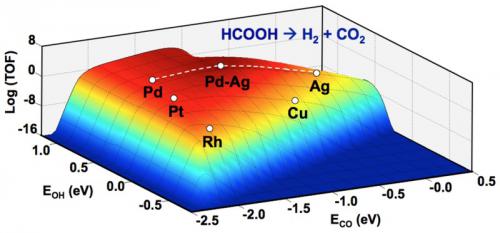Catalytic activity volcano for formic acid decomposition into H2 and CO2 on (211) transition-metal surfaces. The logarithms of the turnover frequencies (TOF) were plotted as functions of CO and OH adsorption energies (ECO and EOH). The white dashed line illustrates the interpolation concept of adsorption energy used to identify potentially active binary alloys for formic acid decomposition into H2 and CO2.
Hydrogen stored in formic acid can be released on demand by decomposing formic acid into H2 and CO2 over suitable catalyst materials.
Researchers at SUNCAT employed density functional theory calculations to investigate the reaction mechanism and the energetics of formic acid decomposition on Ag, Cu, Pd, Pt and Rh surfaces. They found that formic acid decomposition proceeds via dehydrogenation rather than dehydration on most transition-metal surfaces, although the minimum energy pathway varies depending on the surface. Scaling relations of adsorption energies have been used succesfully to describe adsorption energies of the reaction species in terms of two independent descriptors: CO and OH adsorption energies. By incorporating these scaling relations in a microkinetic model, the kinetics of formic acid decomposition have been obtained as functions of the two descriptors (see figure). The trends in catalytic activity and selectivity from one transition-metal surface to another, obtained from the first principles, are in agreement with those obtained from experiments. Importantly, the interpolation concept of adsorption eneries can be used to quickly identify potentially interesting alloy catalyst materials for formic acid decomposition into H2 and CO2.

